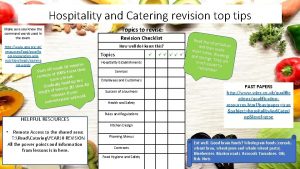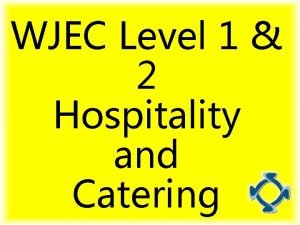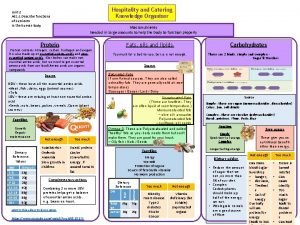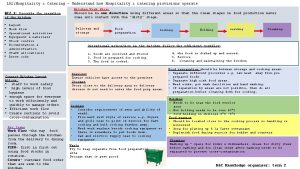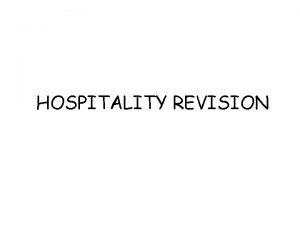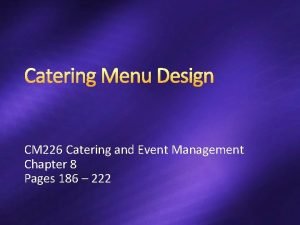Hospitality Catering Understand how Hospitality Catering 3 1






- Slides: 6

Hospitality & Catering – Understand how Hospitality & Catering • 3. 1 personal safety in the work place Personal safety Employers( business) & employees (staff) & Have a responsibility to responsibilitie • Prevent accidents s in the work • Ensure the business is a safe working place environment Identifying • Ensure food is safe to eat risks Health & Safety at Work Act (HASAWA) Control measures • • Employers responsibilities • • • Employees responsibilities Equipment-tested for safety & properly maintained Chemicals- stored and used correctly Training – all staff trained Risk assessments- should be in place Healthy & safety policy – given to all staff Safety equipment – given to staff • • • Safety – work in a safe way Rules – follow all rules Training- attend all training Report – any health or safety risks Equipment – wear safety equipment at all times Reporting of Injuries, Diseases and Dangerous Occurrences Regulations (RIDDOR) Covers work place accidents e. g. Deaths, serious burns , near-miss events e. g. machinery collapsing , work related diseases, gas leaks … Employers responsibilities; • Record all accidents & injuries • Report- all accidents & injuries to the Health & Safety Executive (HSE) Employees responsibilities • Report to their line manager of any possible risks • Accident book- record any injuries Control of Substances Hazardous to Health (COSHH) provision meets Health & Safety requirements Manual handling Operations Regulations (MHOR) Risk to security Covers accidents when lifting heavy/awkward shaped boxes, items that are hot/frozen/sharp Employers responsibilities; • Risk assessment – carried out & completed • Reduce the risk • Avoid any lifting /handling that may cause harm way to staff Correct to lift way to lift Employees responsibilities • Training – how to left carefully • Asses risk – knowing their own strength, ask for help. Arson, vandalism, assault, robbery, fraud, theft , terrorist attack, undesirable people on the premises, burglary. wrong Hazard- something that could cause harm to someone’s health/physically injure them e. g. trips and falls, cut and burns , ingesting chemicals, electric shock, & food poisoning Risk- how likely is it that someone may Personal Protective Equipment at Work Regulations (PPER) be harmed or injured by a hazard? Identify & assess the Control – a way of reducing the risk of This covers personal clothing & equipment level of risk involved. hazard causing harm Risks can occur in Employers responsibilities; Employees responsibilities • Provide suitable protective • Training – attend all sessions • Using equipment e. g. deep clothing e. g. gloves, face • To wear PPE in the work place fat fryers masks, water proof aprons, when instructed to by the • An activity e. g. carrying goggles, hi vis etc. employer a heavy pan • Signage – to remind employees what PPE to wear • A situation e. g. • Provide training on how to wear evacuating the kitchen PPE from a gas leak Calculating risk Covers substances that are hazardous to health e. g. cleaning material chemicals, fumes, dust (flour, icing sugar) gases from cookers. Employers responsibilities; • Stored- labeled correctly to warn people if toxic and stored properly • Care- given to use and disposal of any chemicals Employees responsibilities • Training attend training on how to use safely • Instructions- follow all instructions • symbols 1. 2. 3. 3. 2 Risks to personal safety in hospitality and catering Risk to health& personal safety hazardous Risk assessment – Poor lighting, inadequate signage, fire/explosion, using hazardous chemicals, trip hazards, food poisoning, lifting or moving objects, bullying & harassment, inadequate ventilation, using equipment, injuries e. g. burns & cuts. H&C Knowledge organiser 4. 5. Identify the hazard Who might be harmed & how Evaluate the risks & decide on precautions Record findings & implement them Review and update if necessary

3. 3 personal safety control measures - employees Calculating risk cont. . Hazard severity Likelihood of occurrence scale Trivial Almost never 1 Minor Unlikely Moderate Serious Risk Control measures Stress, fatigue Monitor employees closely & have adequate rest breaks Using equipment Instruction manual needs to be followed , training given if needed 2 possible 3 Trip hazards Clutter free floors, exits & entrances need to be clear likely 4 Spillages Clean up any spillages , use warning signs Using hazardous chemicals Wear protective clothing, training should be given on correct use, chemicals need to be stored correctly COSHH regulations need to be followed Fatal Very likely 5 Level of risk = hazard severity x likelihood of occurrence Low risk 1 -8 - continue but review regularly Inadequate PPE Medium 9 -12 – continue but add other controls where possible to monitor Using regularly electrical High 15 -25 STOP ACTIVITY! Identify new appliances controls, activity cannot proceed until Control measures forlevel customers risks are reduced to low or medium Correct PPE should be worn at all times Equipment should be maintained and regularly cleaned , training given if needed, should be PAT tested regularly by an electrician. Hazard control Food poisoning Hazard analysis and critical control points (HACCP) As system put in place to ensure food is safe to eat. Food allergies Detailed information must be given to the customer allergens in the dishes Trip hazards Good lighting and clear walk ways Spillages (food & drink) Must be cleaned up straight away, appropriate signage must be used Theft /fraud Make sure all card transactions are done in front of the customer. Undesirable people on the premises Any suspicious person should be challenged and not allowed to mix with the customers. Assault Staff should ensure that the safety of other customers is a priority if another person becomes aggressive. fire & explosion Emergency exits should have clear signage and be well lit , fore extinguisher should be in place and staff should be on any Check points Do you know… • Three safety reasons why everyone should follow health and safety rules at work • What RIDDOR stand for? • What COSHH stands for? • Three types of personal protective equipment? • What a risk is? • What a hazard is? • What a risk is • What a risk assessment is? • 6 risks to the employee • 2 risks to the customer Hospitality & Catering Knowledge organiser:

Hospitality & Catering – Know how food can cause ill health AC 4. 1 • Bacteria • Microbes • Chemicals • Metals • Poisonous plants • Allergies • intolerances Causes of food related illness can be split into 3 categories; 1. Microbes –Bacteria, yeast & mould 2. Chemicals, metals & poisonous plants temperature facts 0°c - 5°c Fridge temperature-bacteria become dormant at low temperatures 5°c - 63°c The danger zone bacteria rapidly multiply especially at room temperature or body temperature 37°c -18°c Temperature of a freezer – bacteria become dormant until food is defrosted 3. Food allergies & intolerances 1. MICROBES - Tiny micro-orgasms which contaminate food and spoil it and cause ill health. Bacteria, yeast and moulds are micro-organisms. BACTERIA- can be good or pathogenic & cause food poisoning. Conditions needed for bacterial growth • • MOISTURE TIME- MULITPLIES THROUGH BINARY FISSION EVERY 20 MINUTES WARMTH- MULTIPLY IN WARM CONDITIONS 37°c FOOD – USUSLLY HIGH PROTEIN – HIGH RISK FOODS E. G. MEAT, FISH, DAIRY, EGGS, RICE Microbes from one place can be easily transferred onto some food, where they will contaminate it. e. g. preparing raw chicken on a chopping board and then using the same one to make a sandwich Sneezing into your hand , then handling food without washing your hands in between. Food poisoning 63°c + Hot-holding food 75°c Core temperature of food Mnemonics Days of the week Cross-contamination Test your temperatures Monday/Tuesday/Wednesday /Friday cooked What is food poisoning? • An unpleasant illness that can lead to severe health problems and in some cases death. In elderly, very young, people who have been ill and have a weakened immune system • Pathogenic (harmful) bacteria is the most common cause of food poisoning The symptoms of food poisoning Ac 4. 5 Clothing People Sewage Soil Raw food Equipment Air/dust pests Surfaces Non-visible Visible • Headache • Weakness • • • Diarrhoea High body temperature Vomiting • Feeling cold and shivery • • Bad stomach ache Loss of appetite and feeling sick Aching muscles • Dizziness • Food waste water High risk foods Animals Rubbish Food packaging H&C Knowledge organiser Prevention during storage, preparation & cooking Storage FIFO – first in first out (stock rotation old at front new at back) Chill foods within 90 minutes Wrap high risk foods & store on correct shelf in the fridge to avoid spillage Check use dates Cover dried foods Preparation &cooking Wash hands before cooking, after touching raw foods, sneezing or coughing, cover cuts blue plasters. Use correct coloured chopping boards Keep cooked and raw foods separated Keep fridges at the correct temperature – check every 2 hours. Check temperatures of hot held foods.

Hospitality & Catering – Know how food can cause ill health Yeasts AC 4. 4 - common types of food poisoning Bacteria type Onset time Duration of symptoms Sources ( where it comes from) salmonella O: 2 -3 days D: 7 days Diarrhoea, stomach pain, vomitinmg Raw meat /eggs campylobacter O; 12 -72 hours D: up to a week Diarrhoea, may be bloody, stomach cramps &vomiting Poultry and unpasteurized raw milk E-coli O: 2 days D: up to 10 days Diarrhoea, may be bloody, stomach cramps &vomiting Undercooked ground beef(faeces in intestines)unpast eurized dairy, raw fruit &vegwater on crops Clostridium perfingens O: within hours D: up to 2 days Diarrhoea, may be bloody, stomach cramps NO vomiting Raw meat, gravies, food left for long periods of time at room temperature - a single-celled fungi found in the air reproduces by budding (yeast cells produce a bud , which becomes larger and then breaks off and becomes a new yeast cell) • • Yeast can grow in sweet and acidic foods e. g. orange juice Wild yeast is used to make sour dough bread • Can grow with(aerobic) or with out(anaerobic) oxygen • • Prefers moist food Grows best in warm conditions but can also grown in fridge temperatures 0°c-5°c Destroyed at temperatures above 100°c Yeasts make food unfit to eat by Breaking down the sugars into CO 2 gas and alcohol (fermentation) Moulds -are tiny fungi, related to mushrooms and there are lots of different types. With the correct conditions mould will multiply and make food unfit to eat Need moisture, time, warm temperatures, food & the right amount of acidity. • Will grow slowly in the fridge • Grows where thee is a lot of moisture e. g. inside a plastic container Task: using the table headings above add • Listeria • Bacillus cereus • Staphylococcus Moulds- send out spore which land on the surface of food If conditions are right spore germinate and send roots down into the food H&C Knowledge organiser

Hospitality & Catering – Know how food can cause ill health Allergies • • • Some people experience an allergic reaction when they come into contact with a specific food. The allergic reactions are caused the body’s immune system reacting to the food which can be fatal. Most common foods to cause an allergic reaction Sesame seeds Symptoms – skin rash, itchiness of skin eye and mouth, swollen lips , face eyes, difficulties in breathing Food Intolerances Some people have a sensitivity to some foods. Consuming these food can cause nausea, abdominal pain, joint aches and pains tiredness and weakness. • Lactose intolerance- milk sugars cannot be digested (lactose) • People need to avoid all dairy produce and look at dairy free e. g. soya milk, coconut milk etc… • Gluten intolerance –people cannot have foods which contain gluten (protein found in wheat , rhy and barley) • People need to follow a gluten free diet. People with coeliac’s disease have neither an intolerance nor allergy but is ab auto immune disease caused by the reaction of the auto immune system to gluten. Chemicals, metals and poisonous plants

Hospitality & Catering – Environmental Health Officer (EHO) EHO’s are employed by the local authorities and overseen by the Food Standard’s Agency to enforce food safety legislation. EHO Role • Inspects businesses where food is stored , handled and cooked making sure food is safe to eat • Check food handlers are trained in food hygiene and safety • Checks that control measures are in place to prevent pest contaminating food • The premises is clean and in good condition • Check that there are risk assessments carried out-( HACCP hazard analysis and critical control points) and are being controlled • Offers advice & training on improving food hygiene and safety EHO have powers to; • enter any business unannounced • Inspect the premises and the food being stored, prepared , cooked and sold • Take food samples away to be tested • Look at data records e. g. fridge/freezer temperatures, staff training records If there is a problem EHO’s are allowed to • Take the food away if they think it is a food safety hazard so it cannot be sold hygiene improvements • Tell the owners to make hygiene improvements within a set time and come back to check they have been done • Close food premises and stop them from selling food if there is a high risk of food poisoning • Give evidence in court if the owners of the business are prosecuted for breaking the law. • Carry out an inspection if a member of the public makes a complaint about poor food hygiene or if one or more people get food poisoning after eating from a business. If a member of the public has food poisoning they need to notify their doctor as food poisoning is a notifiable illness. During an inspection they look for evidence of pests, check equipment used for food preparation, cooking & storage to make sure it is clean, watches how food is prepared & cooked and the level of personal hygiene of the staff, Inspects the food waste system & bins, checks paper work and records kept by the business. Ac 4. 2 AC 4. 3 Food safety legislation Food Safety Act 1990 Applies to all food businesses including non-profit making e. g. charities Ensures that all food is 1. Safe to eat 2. what people expect it to beingredients must be suitable for human consumption 3. Not labeled, advertised or presented in a way that is misleading or false e. g. a meal advertised as beef should actually have beef in it. Food hygiene Regulations apply to all food and drink and their ingredients, at all stages of their production, except for primary production e. g. slaughter of live stock, harvesting crops, milking, catching fish, which have their own regs. 1. Food handled safely and in a hygienic way 2. Identify potential food hazards Know which stages in their food handling activities are critical for food safety i. e. identify where things could go wrong 4 decide what control will be put in place to prevent risks 5. Ensure safety controls are n place and are regular reviewed and maintained. THIS CAN BE ACHIEVED USIGN HACCP Food poisoning outbreak-dr told of symptoms- dr agrees it’s. IS A FOOD SAFETY MANAGEMENT SYSTEM food poisoning – faeces samples taken and analyses at the lab TO ENSORE HAZARDS ARE IDENTIFIED, -if bacteria identified as a cause then the local CONTROLS ARE PUT IN PLACE AND ARE environmental Health Off ice is notified so that the EHO can REVIEWED REGULARLY H&C Knowledge organiser investigate the complaint Food Labeling Regulations. Labels tell customers about the food they are about to buy having certain information needed by law. Protect the consumer, manufacturer and retailer. Food labels should be • Clear and easy to read • Permanent –information not rubbed off easily • Easy to understand • Visible and easily read • Not misleading Information needed by law
 To understand recursion you must understand recursion
To understand recursion you must understand recursion Hospitality and catering revision
Hospitality and catering revision Wjec hospitality and catering
Wjec hospitality and catering Wjec hospitality and catering unit 2 examples
Wjec hospitality and catering unit 2 examples Wjec hospitality and catering knowledge organisers
Wjec hospitality and catering knowledge organisers Eduqas hospitality and catering
Eduqas hospitality and catering Explain factors to consider when proposing dishes for menus
Explain factors to consider when proposing dishes for menus

